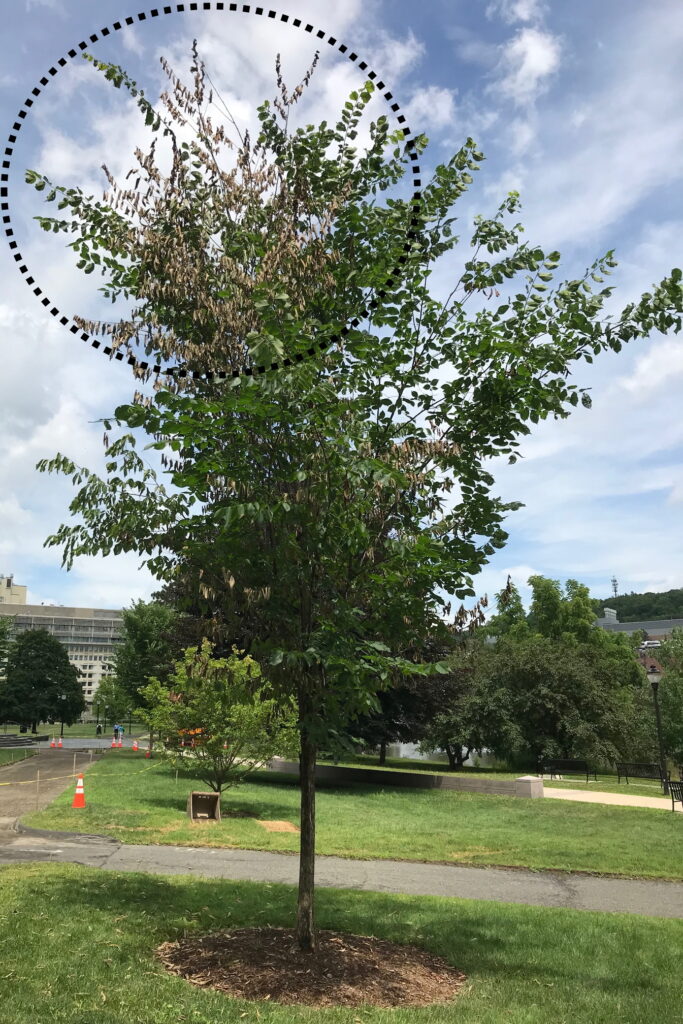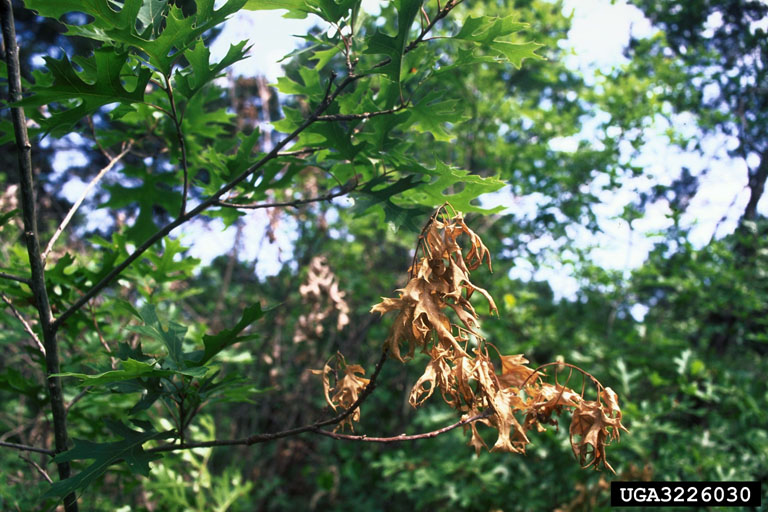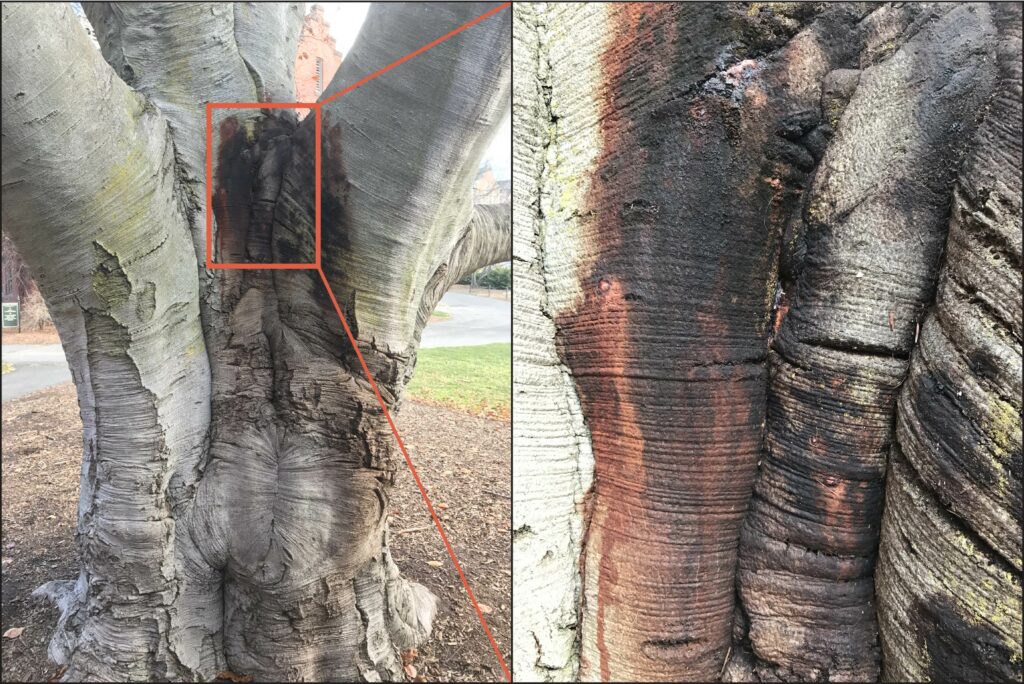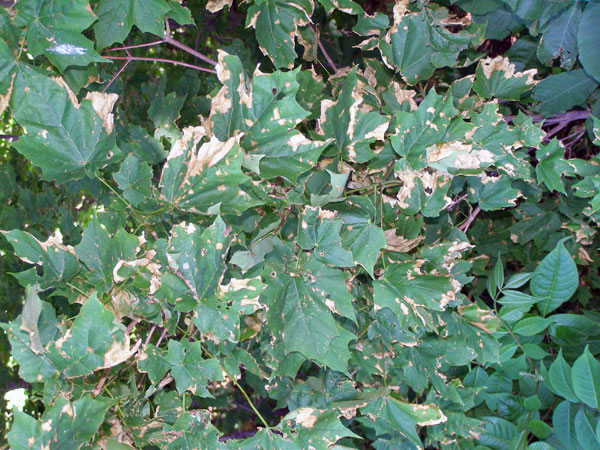Did you know that trees can speak to us? Okay, well not exactly. But they can communicate with us [those of us fluent in tree] issues, whether it’s pests or disease or general stress in trees. They do this simply by expressing a variety of symptoms. There are many forms of tree “communication,” including premature leaf drop in deciduous trees during periods of severe drought, “bleeding” cankers related to pathogens such as Phytophthora a common root fungal disease, the sloughing off of bark from the trunk or large branches, and wilting of foliage, which can be a result of desiccation or stress related to insects or disease.
Flagging Shows Stress in Tree

These symptoms showing a tree may be having an issue might be a dead or dying branch, often referred to by arborists as “flagging.” It’s a condition when tree branches scattered throughout the tree’s crown turn brown, wilt, and die. This condition can be caused by a variety of pests and fungi. These flagging branches are letting us know that the whole tree is in danger! Our professional arborists need to utilize their tree knowledge to detect and determine what that danger is.
Despite the cause, heeding the warning sign that something is wrong may be what saves your tree! Factors such as soil nutrition and hydration don’t directly cause flagging, but they can worsen the situation for the tree. An example of flagging can be seen below in the image of a tree that was infected with Dutch Elm Disease (DED) which is a fungal disease (Ophiostoma novo-ulmi) spread by insects.
Premature Leaf Drop
Flagging isn’t the only way that trees tell us that something is wrong. There are many forms of tree “communication,” including premature leaf drop. Premature leaf drop is prevalent in North Texas’ landscape due to the seasonally dry weather, especially in the summer heat. Trees can be drought damaged by leaf desiccation, slowing of photosynthesis, and slowing of growth. It also causes leaves to wilt or roll, turn off-color, and finally drop. This is known as “premature leaf drop.”

infection. Credit: Bugwood.org
Trees that are in the first three years of establishing their root development are the most susceptible to any extremes in water supply, whether it be too much or too little water. Drought stress predisposes these trees to local insects and disease. Examples of trees that do not tolerate drought well include sycamore (Platanus occidentalis), horse chestnut (Aesculus hippocastanum), sweet gum (Liquidambar styraciflua), Prunus, dogwood (Cornus florida), maple (Acer), pine species (Pinus spp.), Skimmia, Stewartia, and Franklinia. Options for more drought tolerant trees that thrive in Texas include mountain laurels (Kalmia latifolia), eastern redcedar (Juniperus virginiana), bur oak (Quercus macrocarpa Michx), southern live oak (Quercus virginiana), cedar elm (Ulmus crassifolia), bald cyprus (Taxodium distichum), magnolia (Magnolia grandiflora), ash (Fraxinus), and pecan trees (Carya illinoinensis).
“Bleeding” Cankers
“Bleeding” canker is an infection of the bark of several trees by a number of different species of the fungus-like (Oomycete) micro-organism Phytophthora, a common root fungal disease that kills the bark and outer sapwood tissues of trees, causing the affected bark to “bleed” a dark sticky fluid. This fluid is typically reddish-brown and it stains the surrounding bark as it flows downward. Infected bark is often water soaked and stained while the inner sapwood can exhibit a range of abnormal colors depending on the particular species of Phytophthora present.

Phytophthora species do not actually decay the wood; rather they consume sugars in the cambium and outer sapwood. The resulting death of the bark and outer sapwood can leave the tree vulnerable to infection from wood-rotting fungi that then invade at a later time. Phytophthora species originate from the soil and may be causing root disease in addition to the “bleeding canker”. They thrive in wet soils, which stimulate easy spore production and dispersal. These cankers may be present at any time of year and effect a number of trees including maple (Acer), American beech (Fagus grandifolia), birch (Betula pendula), magnolia (Magnolia grandiflora), dogwood (Cornus florida), oak species (Quercus spp.), and walnut trees (Juglans spp.).
Discolored Foliage
Stress from a variety of causes can lead to the sloughing off of bark from the trunk or large branches, and wilting of foliage, which is commonly related to insects or disease. Sometimes trees express the stress that they are experiencing through chlorotic, or discolored foliage. While this chlorosis can be a result of insects or disease, that isn’t the only thing that causes these symptoms in trees. Sometimes the soil where they are growing lacks important micro or macro nutrients required for that tree’s physiological processes and general growth. In contrast, sometimes the soil is heathy, but the tree struggles to access the nutrients that are available in the soil. Both of these situations can potentially lead to trees having discolored canopies.

When plants (trees) are growing in less-than-optimal soil conditions important macro or micronutrients can sometimes be “missing”. Soil tests to determine the actual percentages of nutrients present are always a good idea before beginning a planting project. In most cases, however, soil nutrients are not missing or limited. More often, nutrient deficiencies result from selecting a species of plant that is not well-suited to the intended site. In North Texas this is commonly seen with sweetgum (Liquidambar styraciflua), Shumard oak (Quercus shumardii), and pine species (Pinus spp.). These species prefer more acidic or lower pH soils than the heavy clay soils found in our region which are typically very alkaline or high pH. This discrepancy between the species’ preferred soil pH and the site’s soil pH creates an unfavorable condition where the chemical charges between the soil particles and the available nutrients do not attract or bond sufficiently and thus nutrient uptake is restricted or limited (i.e. Cation Exchange Capacity (CEC)).
Helping Tree Showing Stress
When trees do communicate with us that they are under stress (usually from multiple factors) what can be done? As you can imagine, the answer is that “it depends.” If the principal cause of stress is related to insects or disease, there are often chemical and cultural treatments that can be employed to improve conditions and reduce symptoms. Often there are root health and/or structural issues that must be addressed. Improvement to the soil structure within the tree’s dripline can also be made through aeration or vertical mulching techniques.
Finally, there are both soil injections and trunk injections of iron or other micronutrients that can be conducted to address the symptoms of chlorosis. It’s important to know that many of the above symptoms that trees communicate to us do not happen suddenly or “overnight”. There are usually indications for weeks, months or even years before a tree owner finally observes the problem. The sooner we “hear” the communications of stress coming from our trees the more and better the treatment options are. Preventive care, such as fertilization, is also vital.
Perhaps one of your trees has recently been trying to communicate with you. Do you need a qualified translator? TreeTech can provide Certified Arborists that “speak tree” to help you understand your trees better. Contact TreeTech today to schedule a site evaluation to learn more about how to protect and care for your green investment!

Recent Comments